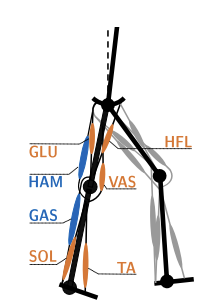Power to the springs: Passive elements are sufficient to drive push-off in human walking

For the impulsive ankle push-off (APO) observed in human walking two muscle-tendon-units (MTUs) spanning the ankle joint play an important role: Gastrocnemius (GAS) and Soleus (SOL). GAS and SOL load the Achilles tendon to store elastic energy during stance followed by a rapid energy release during APO. We use a neuromuscular simulation (NMS) and a bipedal robot to investigate the role of GAS and SOL on the APO. We optimize the simulation for a robust gait and then sequentially replace the MTUs of (1) GAS, (2) SOL and (3) GAS and SOL by linear springs. To validate the simulation, we implement NMS-3 on a bipedal robot. Simulation and robot walk steady for all trials showing an impulsive APO. Our results imply that the elastic MTU properties shape the impulsive APO. For prosthesis or robot design that is, no complex ankle actuation is needed to obtain an impulsive APO, if more mechanical intelligence is incorporated in the design.
| Author(s): | Alexandra Buchmann and Bernadett Kiss and Alexander Badri-Spröwitz and Daniel Renjewski |
| Book Title: | Robotics in Natural Settings |
| Pages: | 21--32 |
| Year: | 2022 |
| Month: | August |
| Series: | Lecture Notes in Networks and Systems, 530 |
| Editors: | Cascalho, José M. and Tokhi, Mohammad Osman and Silva, Manuel F. and Mendes, Armando and Goher, Khaled and Funk, Matthias |
| Publisher: | Springer |
| Project(s): | |
| Bibtex Type: | Conference Paper (inproceedings) |
| Address: | Cham |
| DOI: | 10.1007/978-3-031-15226-9_5 |
| Event Name: | 25th International Conference on Climbing and Walking Robots and the Support Technologies for Mobile Machine (CLAWAR 2022) |
| Event Place: | Ponta Delgada |
| State: | Published |
| URL: | https://arxiv.org/pdf/2205.00871.pdf |
| Electronic Archiving: | grant_archive |
| ISBN: | 978-3-031-15225-2 |
BibTex
@inproceedings{buch2022a,
title = {Power to the springs: Passive elements are sufficient to drive push-off in human walking},
booktitle = {Robotics in Natural Settings },
abstract = {For the impulsive ankle push-off (APO) observed in human
walking two muscle-tendon-units (MTUs) spanning the ankle joint play
an important role: Gastrocnemius (GAS) and Soleus (SOL). GAS and
SOL load the Achilles tendon to store elastic energy during stance followed by a rapid energy release during APO. We use a neuromuscular
simulation (NMS) and a bipedal robot to investigate the role of GAS and
SOL on the APO. We optimize the simulation for a robust gait and then
sequentially replace the MTUs of (1) GAS, (2) SOL and (3) GAS and SOL
by linear springs. To validate the simulation, we implement NMS-3 on
a bipedal robot. Simulation and robot walk steady for all trials showing
an impulsive APO. Our results imply that the elastic MTU properties
shape the impulsive APO. For prosthesis or robot design that is, no
complex ankle actuation is needed to obtain an impulsive APO, if more
mechanical intelligence is incorporated in the design.},
pages = {21--32},
series = {Lecture Notes in Networks and Systems, 530},
editors = {Cascalho, José M. and Tokhi, Mohammad Osman and Silva, Manuel F. and Mendes, Armando and Goher, Khaled and Funk, Matthias},
publisher = {Springer},
address = {Cham},
month = aug,
year = {2022},
slug = {buch2022a},
author = {Buchmann, Alexandra and Kiss, Bernadett and Badri-Spr{\"o}witz, Alexander and Renjewski, Daniel},
url = {https://arxiv.org/pdf/2205.00871.pdf},
month_numeric = {8}
}

